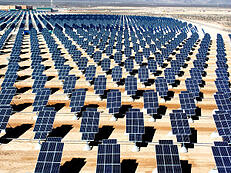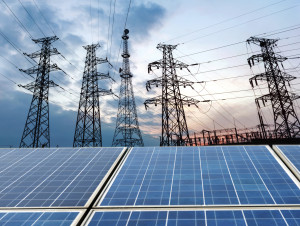As the dust settles amidst the hoopla and angst surrounding the Environmental Protection Agency’s (U.S. EPA) final promulgation of President Obama’s Clean Power Plan (CPP or the final Plan), a theme has emerged – renewables are expected to be a major energy source. From proposal in 2014 to U.S. EPA’s final rule in August 2015, the share of renewables in the agency’s forecast of the U.S. power sector in 2030 jumped from 22 to 28 percent. Concomitantly, the final Plan further highlights the anticipated strong presence of renewable energy resources in the states’ future energy mix.
The question now arises whether enough renewable energy resources can be built to enable the states' to meet their respective carbon emissions from power plants. The answer depends on whether investors will have adequate incentives and financing mechanisms to “prime the pump” and generate the requisite megawatts of renewable energy to help meet the final Plan’s emission reduction targets.
The Final Plan’s Approach to Carbon Emission Reduction
The CPP’s goal is to reduce carbon emissions from stationary energy-generating sources such as coal and gas power plants. In the final Plan, U.S. EPA assigned each state a specific emissions reduction target. The agency then provided the states with discretion and flexibility to decide how to meet those targets within the context of the CPP’s designated “building blocks” (discussed later). However, if a state fails to submit an adequate implementation plan by the 2016 or request an extension for plan development until 2018, U.S. EPA will assign the state a federal implementation plan (FIP) that will enable that state to meet its emission reduction target. A sample FIP, which creates an opted-in cap-and-trade marketplace, was released with the final Plan on August 3, 2015.
Establishment of Emissions Reduction Rates: Section 111(d) of the Clean Air Act requires that U.S. EPA determine the “best system of emissions reduction” (BSER) for pollutants such as carbon dioxide. To achieve this result, the agency examined the technologies, strategies, and measures previously implemented by states and utilities to reduce emissions at existing power plants.
 This examination yielded three “building blocks” in the final rule that a state may use to meet emission reduction targets. It may improve heat rates at existing power plants to make them more energy efficient (Building Block 1); use more lower-emitting energy sources like natural gas rather then higher-emitting sources like coal (Building Block 2); and/or use more zero-emitting energy sources like renewable energy (Building Block 3). U.S. EPA then considered the ranges of reductions that could be achieved at existing coal and natural gas power plants at a reasonable cost by application of each building block.
This examination yielded three “building blocks” in the final rule that a state may use to meet emission reduction targets. It may improve heat rates at existing power plants to make them more energy efficient (Building Block 1); use more lower-emitting energy sources like natural gas rather then higher-emitting sources like coal (Building Block 2); and/or use more zero-emitting energy sources like renewable energy (Building Block 3). U.S. EPA then considered the ranges of reductions that could be achieved at existing coal and natural gas power plants at a reasonable cost by application of each building block.
The building blocks were applied to coal and natural gas plants across the three U.S. interconnection regional grids - the Western interconnection, the Eastern interconnection, and the Electricity Reliability Council of Texas interconnection. The analysis conducted by U.S. EPA produced regional emission performance rates - one for coal plants and one for natural gas plants. The agency then chose the most readily achievable rate for each source (both calculated from the Eastern interconnection) and applied the rate uniformly to all affected sources nationwide to develop rate-based and mass-based standards. Although this approach created uniformity, nonetheless, each state still was assigned a different emissions target based on its own specific mix of affected sources.
Plan Implementation: As noted, U.S. EPA has enabled the states to decide the manner in which to meet their reduction targets. Thus, the CPP does not mandate specific changes to a state’s fuel mix; rather, states are free to determine how best to meet their emission reduction targets. For example, as applicable, a state may focus solely on Building Block 1 and making efficiency improvements at existing coal and natural gas plants. Conversely, a state may focus on Building Block 3 and incentivize development of more zero-emitting energy sources. Or, all three of the building blocks may be used to achieve a state’s targets.
The CPP’s approach to achieving compliance is notable because critics have argued that, under Section 111(d) of the Clean Air Act, U.S. EPA cannot regulate beyond the “fence line” (e.g., the agency can only regulate a power plant itself, and cannot count unrelated energy efficiency measures and renewable energy development toward achieving compliance). In an apparent effort to shield the CPP from legal challenges, the agency removed demand-side energy efficiency improvements as a building block in the final rule. Moreover, by not forcing the states to utilize a particular mechanism to achieve compliance, the agency’s decision-makers seem to believe the final Rule is better positioned to withstand the inevitable appeals process.
- Larger Role Expected for Renewables: U.S. EPA contemplates that renewable energy will play a prominent role in the evolving U.S. power sector. The draft rule estimated that by 2030, 22 percent of the country’s electricity would be generated by renewable resources. In the final Plan, EPA estimates the share of renewables at 28 percent. According to the agency, this increase is a function of market forces and a continued decline in energy prices. It also is in line with the final Plan’s deeper cuts to emissions overall. The final Plan targets a 32 percent decline in carbon dioxide emissions from 2005 levels by 2030, whereas the proposed rule had a 30 percent reduction goal. Nonetheless, whether sufficient renewable energy resources are developed to help meet the final Plan’s emission reduction targets depends on whether sufficient incentives exist and risks can be adequately minimized. Potential investors dislike uncertainty, especially when it involves committing large amounts of funding to development projects over a lengthy time horizon.
- Incentives for Renewables: The final Plan seeks to incentivize the deployment of renewable energy through early renewable procurement under EPA’s Clean Energy Incentive Program, which makes available additional allowances or emission credits for investments in zero-emitting wind or solar power projects during 2020 and 2021, prior to the rule's 2022 implementation date. As discussed below, other incentives may be provided by the U.S. Department of Energy and Congressional action on favorable tax legislation.
- Coordinating Role with the Department of Energy: President Obama recently announced a coordinating role for the Department of Energy (DOE) in connection with the CPP. The DOE’s Loan Programs Office (LPO) will make available up to one billion dollars in loan guarantees to support commercial-scale distributed energy projects, such as rooftop solar with storage and smart grid technology. Expanded funding also is available though DOE’s Advanced Research Projects Agency–Energy (ARPA-E), which has awarded $24 million for 11 high-performance solar photovoltaic power projects.
- Seeking Congressional Clarity on Tax Credits: By extending the compliance deadlines from 2016 in the proposed Plan to 2018 in the final Plan, U.S. EPA provided states with additional time to build out the necessary infrastructure to achieve compliance. The deadline extension also provides more time for Congress to establish clarity regarding the federal investment tax credit (ITC). The ITC presently enables investors to credit 30 percent of a project’s costs to their taxable basis, but the credit is scheduled to decrease to 10 percent on January 1, 2017 without a Congressional extension.
 For renewable energy, and particularly solar, to play a seminal role in effectuating the final Plan requires a functioning solar market. Solar projects are characterized by high upfront costs and long payout periods. Without supportive policies like the ITC, solar developers may face difficulties finding suitable power purchasers, thus negatively impacting the ability to procure financing. Further, utilities may be unable to bear the full costs of the CPP without assistance from the private market. Utilities typically procure power from already-financed projects. If required to underwrite solar on their own, utilities may need to finance such projects using their credit rating and balance sheet, thus passing along infrastructure costs to ratepayers.
For renewable energy, and particularly solar, to play a seminal role in effectuating the final Plan requires a functioning solar market. Solar projects are characterized by high upfront costs and long payout periods. Without supportive policies like the ITC, solar developers may face difficulties finding suitable power purchasers, thus negatively impacting the ability to procure financing. Further, utilities may be unable to bear the full costs of the CPP without assistance from the private market. Utilities typically procure power from already-financed projects. If required to underwrite solar on their own, utilities may need to finance such projects using their credit rating and balance sheet, thus passing along infrastructure costs to ratepayers.
Although some solar proponents believe the ITC step-down will not negatively affect the market’s vitality because the price of renewables is now cost competitive enough to survive the shift, others in the industry dispute this view. Irrespective, the upcoming ITC step-down creates uncertainty in the market. The Production Tax Credit (PTC), generally associated with wind projects, recently passed through the Senate Finance Committee, provides the potential for a similar ITC revival. With the additional compliance period granted to the states in the final rule, Congress now has the opportunity to provide clarity by acting favorably on both of these tax credits by late-2016.
State Incentives
Renewable energy-friendly states have enacted legislative, promulgated regulatory enforcement mechanisms, and provided financial incentives to encourage the development of renewable energy resources. For example, some states participate in cap-and–trade programs (e.g., Regional Greenhouse Gas Initiative (RGGI)), have enacted renewable energy portfolio standards, provide favorable treatment under public utility commission regulations (e.g., favorable net-metering schemes and third-party financing for renewable energy development), and offer other state or local tax credits. The impact of such programs on carbon emission reduction is reflected in the lower targets assigned under the final Plan, for example, to California and Massachusetts - 13.2 percent (126 lbs. CO2 / MWh) and 17.8 percent (179 lbs. CO2 / MWh), respectively.
Despite Emphasis in the Final Plan, Uncertainty Still Remains Regarding Renewables Development
The final Plan provides a level of regulatory clarity, but the path forward remains uncertain in light of looming legal battles regarding whether the Plan oversteps U.S. EPA’s authority under the Clean Air Act and political divisiveness in Congress. It also is unknown whether the next U.S. President will support the rule or try to dismantle the Plan.
These uncertainties, coupled with concern over the future of the ITC, may lead to substantial implementation delays, or even complete eradication or substantial revision of the final Plan. Even if the CPP withstands challenge, nonetheless, some states may be unable to meet their emission reduction targets if adequate renewable energy financing mechanisms have not developed by 2018, the time by which state's must submit their emission reduction plans. Understandably, potential investors may be leery about committing substantial funds to renewable energy projects unless or until the likely outcome of legal challenges to the CPP can be better assessed, and regulatory and political risks more accurately calculated.
While renewable energy resources seem to be a favored approach under the final Plan, a comprehensive strategy that effectively facilitates the financing of such projects is essential to achieve the Plan’s emission reduction targets.



.jpg?width=220&name=Sullivan%204c(B2402503).jpg)